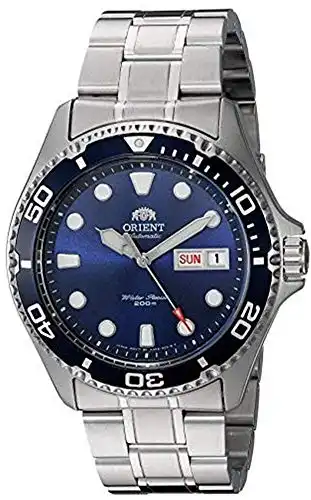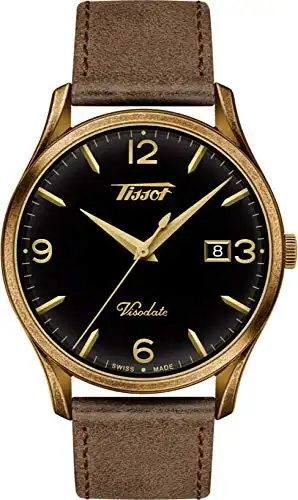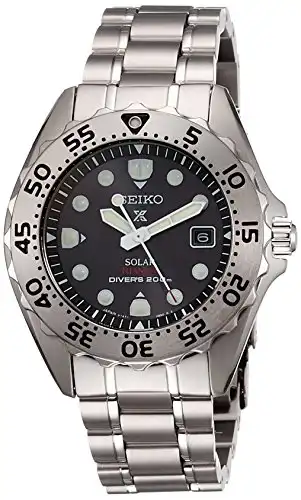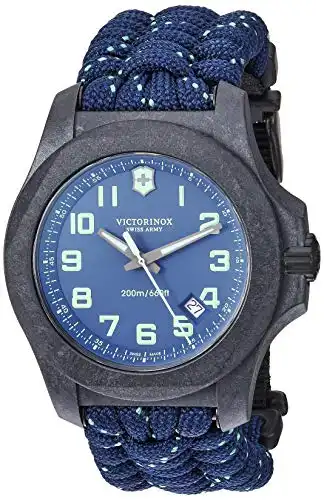Understanding the differences among all the different
Stainless steel, platinum, and white gold all look so similar. Why would I want to pay more for one or the other? If tungsten is so strong, why won’t watchmakers build more?
It’s okay! We’re here to help. Why don’t we dive into it!
watch made of?
There’s a lot of
Steel Watch es
Steel is an alloy of iron strengthened by carbon; stainless steel infuses with a chemical element called chromium, which prevents the steel from rusting. The result is a compound that’s durable and shiny.
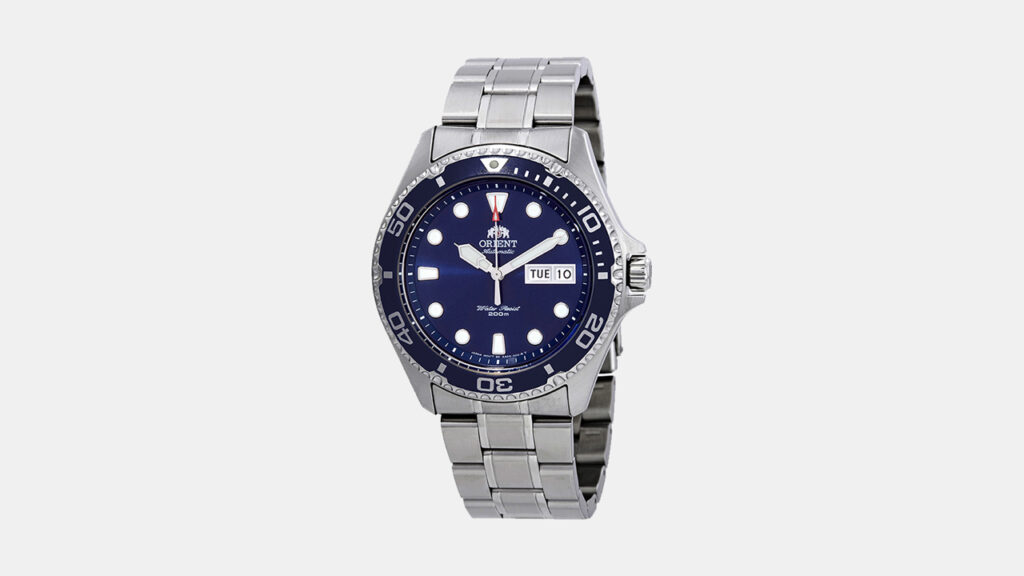
This diver is highly revered, garnering respect from even the snobbiest watch buyers, and is the closest to a Rolex Submariner for under $200.
Stainless steel is understandably the most popular metal for wristwatches, especially high-end sport watches. Originally only acceptable for tools, Rolex launched stainless steel into common usage as well as high-esteem.
Today, watches of any style are acceptable in stainless steel, though some purists would still prefer a leather band for evening wear.
As we mentioned in our exploration of
Tungsten Watch es
Tungsten is a shiny, high-density white metal. It’s most famous as a filament in light bulbs and isn’t always used for
Of all the metals, tungsten has the highest melting point and the second highest boiling point. It’s nearly indestructible and equal in hardness to sapphire.
There are two reasons why tungsten isn’t commonly used for
You’ll find tungsten in small run special editions and
Silver Watch es
Silver used to be used as a dressy option for
It’s a beautiful metal and a natural germicide and antibiotic, which makes it perfect for high-end dinnerware. However, it’s simply too weak for wristwatches, and is no longer commonly used.
Silver also oxidizes poorly, which means it can leave unsightly stains on your
If you like pocket
Gold Watch es
It goes without saying that gold, especially yellow gold, is a dress
It’s known for being heavy but soft, so it’s often mixed with other metals. The highest concentration is 24 karats.
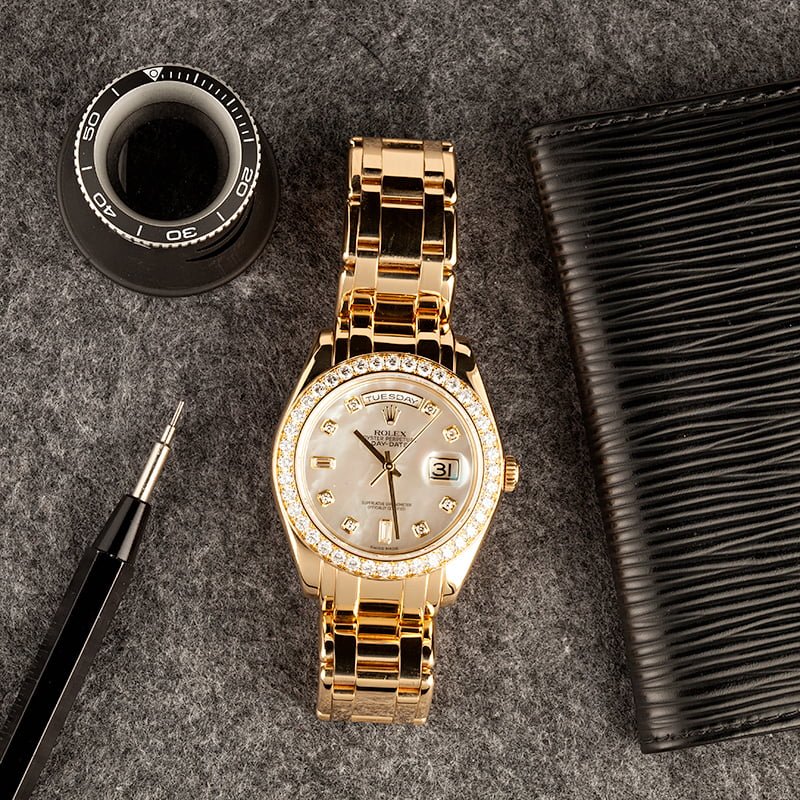
If you don’t like the delicate wear of a traditional dress
White gold is mixed with nickel and zinc to imitate platinum, while rose gold is mixed with copper for a warmer hue. Many brands have their own proprietary gold, like Omega’s Sedna which is often used to make dress
Two things to keep in mind though: Gold easily scratches, and high-end, entry-level watches don’t hold their value as well in precious metals as they do in stainless steel.
Platinum Watch es
Platinum looks a lot like white gold, and they’re often stylistically interchangeable.
It’s as striking and luminous as gold, but it’s much more durable, lighter, and naturally hypoallergenic since it isn’t infused with nickel like white gold is.
The kicker is that it’s more expensive than white gold.
If you’re dead-set on having a precious metal
Brass and Bronze Watch es
Brass and bronze are copper-based metals that give
There are some fundamental differences between brass and bronze. Brass is stronger than gold, but softer than steel, so it’s a great material for detailed
Both are resistant to seawater corrosion, which has made them a popular and practical choice for divers and tool
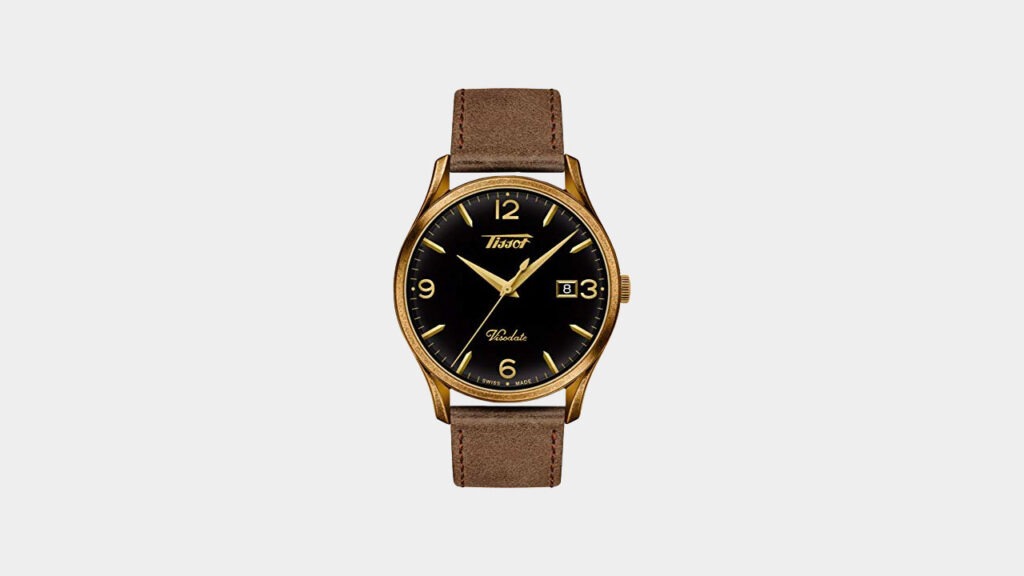
If you want to be adventurous without overtly breaking any rules, brass and bronze are great options. Since stainless steel is de rigueur these days, brass and bronze have an off-the-beaten-path look about them.
They also develop a desirable patina over time.
You’d be surprised at how versatile this metal can be. For example, military
Panerai
Titanium Watch es
Titanium is lustrous and silver in color, with low-density and high durability.
It’s not as scratch-resistant as stainless steel, but it’s much stronger and dent-resistant. Since it doesn’t contain nickel, it’s also hypoallergenic. It’s often used as an alternative to stainless steel for those with allergies or those looking for something lighter in feeling.
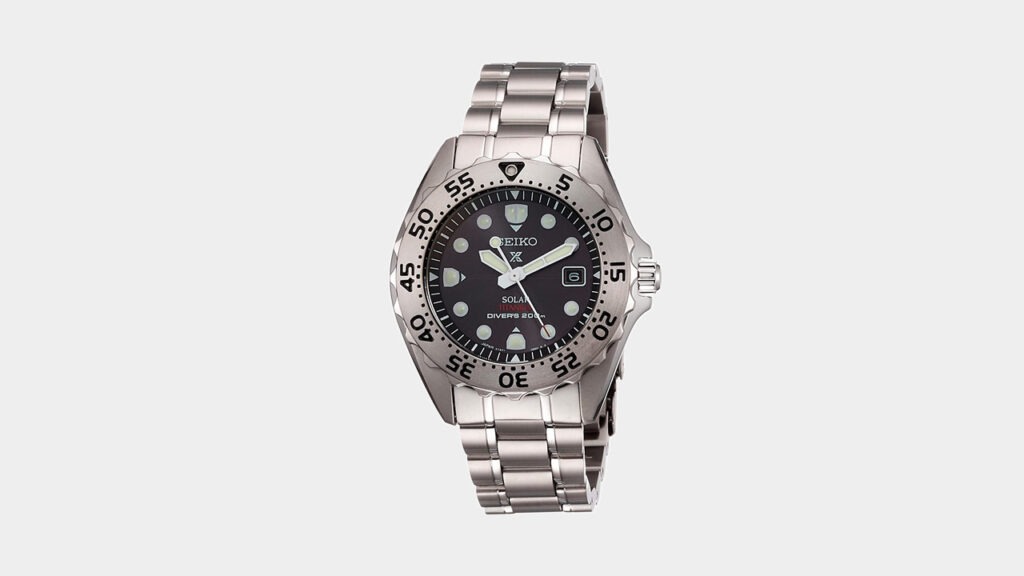
Unfortunately, it’s much more expensive than stainless steel. It’s certainly shiny enough, but it’s not as reflective as stainless steel either.
The Citizen X8 Chronometer, released in 1970, was the first titanium
I love titanium for chronographs, particularly in Speedmaster homages — totally appropriate since titanium is often used in aeronautical experiments.
Ceramic Watch es
Ceramic is created by melting and cooling chemicals, then milling them into shape.
It isn’t actually metal, but is often polished to create a metal-like sheen.
Why use ceramic instead of actual metal, you may ask? It’s four times harder than stainless steel, lightweight (used in jet engines and NASA heat shields), and it can be created in several finishes.
It’s also resistant to ultraviolet rays, so the color won’t fade. This is particularly useful for blacked-out
Aesthetically, ceramic is usually designed to sit remarkably between matte and shiny. This makes it perfect for contemporary pieces like the Apple
Carbon Fiber Watch es
Another metal-like non-metal, carbon fiber is five times stronger than steel and a third as light.
The material used for
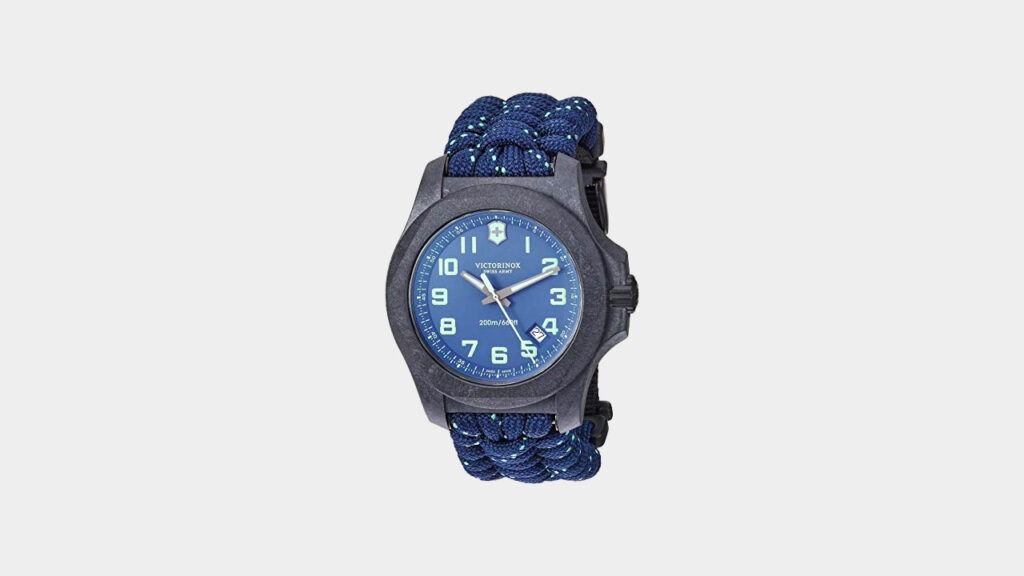
This process is difficult for mass-production, so carbon fiber
It’s a matte, textured material that has a futuristic and utilitarian look. It goes well with tactical sport
Metal Watch Coatings: PVD and DLC
PVD, or Physical Vapor Deposition, is a process of coating. DLC, or Diamond-like Carbon, is a coating applied to
PVD (or Physical Vapor Deposition)
Physical Vapor Deposition adds a thin coat of metal compounds onto the base metal of a
PVD coating reduces friction and increases temperature and impact strength. It also gives the
While not invincible, a PVD coating won’t wear off on its own and is almost impossible to scratch off.
DLC (or Diamond-Like Carbon)
Diamond-like Carbon consists of carbon particles that are chemically applied to the
Colors range from dark grey to a deep black.
Watch Metals: A Reference Chart
Here’s a quick reference chart listing all the
| Metal | Traits | Commonly used for |
| Steel | Durable and lustrous. Affordable and versatile. Corrosion-resistant | Originally used for tool |
| Tungsten | Nearly indestructible. Highest melting point of any element, corrosion-resistant. Difficult to work with | Special edition |
| Silver | Naturally antibacterial. Lustrous, soft, malleable. Tarnishable | Vintage |
| Gold | Lustrous, soft, malleableEasily scratched. Easily conducts heat | Dress |
| Platinum | The strongest precious metal. Resistant to tarnishing and corrosion. Soft and malleable | Dress |
| Brass/Bronze | Unique, reddish color. Corrosion-resistant. Develops desirable patina over time | Sport |
| Titanium | Durable and lightweight. Hypoallergenic. Expensive | Experimental tool |
| Ceramic | Durable but brittle, lightweight, scratch-resistant. Can be made in different colors that won’t fade. Hypoallergenic | Modern |
| Carbon Fiber | Durable and lightweight. Matte and textured. Expensive | Tactical sport |
What are the best watch metals for everyday watches ?
All things considered, the winner is stainless steel, with titanium as a close second.
Stainless steel is equal parts affordable and durable, which is why it’s so popular. Titanium is more durable, and even lighter, but far more expensive.
What’s the most common watch metal?
It’s telling that the most common
Despite being a utilitarian accessory,
Because it’s strong and corrosion-resistant, stainless steel keeps its luster much longer than any precious metal can. Unlike precious metals, it’s the best of both fashion and practicality.
What’s the most durable metal for watches ? What about the most scratch-resistant metal?
Tungsten is the most durable metal for
Unless you have special reasons (and the budget!) to opt for tungsten or titanium, go for stainless steel when thinking about durability and scratch-resistance!
Are gold and platinum watches all gold / platinum?
100% gold would be way too soft, so it’s always mixed with another metal when used for
Here’s the percentage purity of each:
- 24-karat gold is 99% pure gold
- 18-karat gold is 75% pure gold
- 14-karat gold is 15% pure gold
- Gold plating is .05% purity
Platinum, on the other hand, is way too hard to be 100%. Typically a platinum
Are gold / platinum watches better than other watches ?
The short answer is no.
There are several variables that make a good
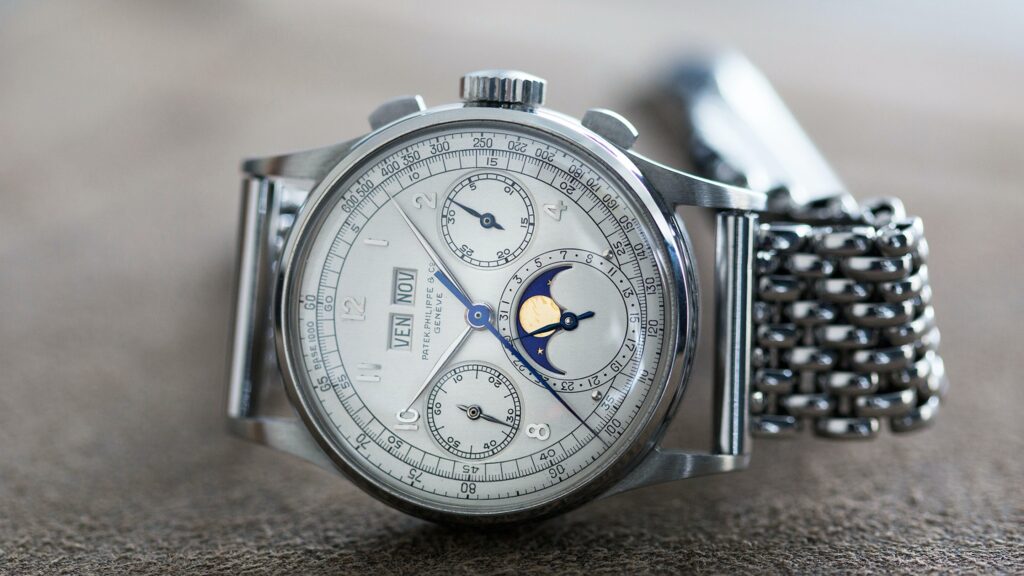
For example, Patek Philippe’s 1518 in steel is valued much higher than in gold. Why? Because the steel version was built out of desperation during a gold embargo and only four of them exist.
However, a vintage Vacheron Constantin Chronometre Royal 4907 in white gold is a highly desired piece by collectors.
Yes, it’s a rare
Remember that horology is as much science and engineering as it is art. So while precious metals are “pretty”,
To an extent, complications also affect rarity. Building a perpetual calendar or chronograph complication, for example, takes more horological skill than working with white gold.
A watchmaker can build a larger number of simple
And of course, rarity is a huge factor when it comes to value.
So using precious metals can make for a better
At the end of the day, there’s no “better”
watch metals help?
We hope this was helpful!
- Need a super strong
watch and have the budget to spare? Titanium is a great option. - Looking for a unique tool
watch that doesn’t scream for attention? Try a bronzewatch . - And of course, you can’t go wrong with stainless steel.
The best part about having a
If you have any questions or comments, hit me up on Twitter. You can also find join other readers on Effortless Gent’s Facebook page, or DM me on Instagram!
Feature image via Pexels

